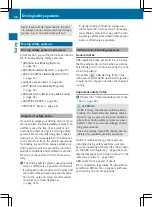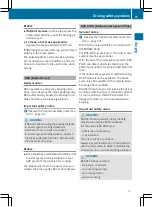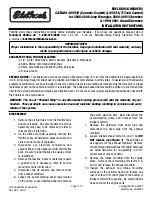
gitudinal body members are hit, and sufficient
deceleration occurs as a result.
If the restraint system control unit detects a
side impact or an overturn situation, the rel-
evant restraint system components are acti-
vated independently of one another depend-
ing on the apparent type of accident. If addi-
tional protection for the vehicle occupants is
determined in this situation, the belt tension-
ers are also triggered.
R
Sidebag on the side on which the impact
occurs, independently of the belt tensioner
and of the use of the seat belt
Vehicles with automatic child seat recog-
nition on the front-passenger seat: the
sidebag on the front-passenger side
deploys under the following conditions:
-
an occupant is detected on the front-
passenger seat or
-
the belt tongue has engaged in the belt
buckle of the front-passenger seat.
R
Headbag on the side on which the impact
occurs, independently of the use of the seat
belt and independently of whether the
front-passenger seat is occupied
R
Headbags on the driver's and front-
passenger sides in certain overturn situa-
tions if the system determines that they
can offer additional protection to that pro-
vided by the seat belt
i
Not all airbags are deployed in an acci-
dent. The various airbag systems work
independently of one another.
How the airbag system works is deter-
mined by the severity of the accident detec-
ted, especially the vehicle deceleration or
acceleration, and the apparent type of acci-
dent:
R
frontal collision
R
side impact
R
overturn
NECK-PRO head restraints
Important safety notes
G
WARNING
The function of the head restraint may be
impaired if you:
R
attach objects such as coat hangers to the
head restraints, for example
R
use unsuitable head restraint covers
If you do so, the head restraints cannot fulfil
their intended protective function in the event
of an accident. In addition, objects attached
to the head restraints could endanger other
vehicle occupants. This poses an increased
risk of injury.
Do not attach any objects to the head
restraints and only use suitable head restraint
covers.
Consult a Mercedes-Benz Service Centre
regarding the availability of suitable seat or
head restraint covers.
Operation
NECK-PRO head restraints reduce the likeli-
hood of head and chest injuries. The NECK-
PRO head restraints on the driver's and front-
passenger seats are moved forwards and
upwards in the event of a rear-end collision of
a certain severity. This provides better head
support.
If the NECK-PRO head restraints have been
triggered in an accident, you must reset the
NECK-PRO head restraints on the driver’s and
front-passenger seat (
Y
page 50). Other-
wise, the additional protection will not be
available in the event of another rear-end col-
lision. You can recognise when NECK-PRO
head restraints have been triggered by the
fact that they have moved forwards and can
no longer be adjusted.
Mercedes-Benz recommends that you have
the NECK-PRO head restraints checked for
functionality at a qualified specialist work-
shop after a rear-end collision.
Occupant safety
49
Safety
Z
Summary of Contents for SLK 2014
Page 2: ......
Page 3: ......
Page 5: ......
Page 41: ...38...
Page 74: ...Useful information 72 Key 72 Doors 78 Boot 81 Side windows 83 Roof 87 71 Opening and closing...
Page 111: ...108...
Page 127: ...124...
Page 141: ...138...
Page 201: ...198...
Page 265: ...262...
Page 266: ...Useful information 264 Stowage areas 264 Features 267 263 Stowing and features...
Page 281: ...278...
Page 315: ...312...
Page 341: ...338...
Page 354: ...351...
Page 355: ...352...
Page 356: ......
Page 357: ......
















































